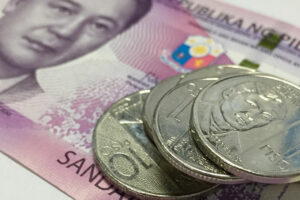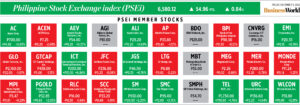Peso sinks to fresh 16.5-year low as BSP hikes rates by just 25 bps

THE PHILIPPINE PESO sank to another over 16-year low against the dollar on Thursday as the central bank raised benchmark rates by just 25 basis points (bps) despite market expectations of a bigger hike following the US Federal Reserve’s aggressive move last week.
The local unit closed at P54.70 versus the dollar on Thursday, shedding 23 centavos from its P54.47 finish on Wednesday, data from the Bankers Association of the Philippines showed.
Thursday’s close is a fresh 16-1/2-year low as it is the peso’s worst finish since Nov. 21. 2005’s P54.74.
The peso opened Thursday’s session at P54.40 against the dollar, better than its Wednesday finish. Its intraday best was at P54.35, while its closing level was its worst showing for the day.
Dollars exchanged fell to $1.061 billion on Thursday from $1.348 billion.
The peso weakened further as the Bangko Sentral ng Pilipinas (BSP) hiked rates by just 25 bps on Thursday and signaled a continued “gradual” pace of tightening, Rizal Commercial Banking Corp. Chief Economist Michael L. Ricafort said in a Viber message.
Mr. Ricafort noted that the BSP’s dovish tone comes even as the Fed is expected to fire off “bigger and faster” increases in the coming months.
“Market sentiment was also weighed down by the acknowledgment of Fed Chair Powell of recession risks due to more aggressive Fed rate hikes/monetary policy and signaling that soft landing would be very challenging,” he added.
The BSP’s decision on Thursday came despite market expectations of a 50-bp move following the Fed’s hawkish turn. It followed an increase of the same magnitude at its May 19 meeting that kicked off the BSP’s tightening cycle following the cumulative 200 bps in cuts made in 2020 to support the economy amid the coronavirus pandemic.
Headline inflation reached 5.4% in May, faster than the BSP’s 2-4% target for the year. Year to date, inflation has averaged 4.1%.
The BSP on Thursday also raised its inflation forecasts. For 2022, it now sees inflation averaging 5% from 4.6% previously, which, if realized, would be the fastest since the 5.2% print logged in 2018. The 2023 forecast was also hiked to 4.2% from 3.9% previously.
The Fed chief told the US Senate Banking Committee on Wednesday that the US central bank is committed to fighting inflation and is not trying to provoke a recession.
The Fed last week raised rates by 75 bps — its biggest hike since 1994 — to a range of 1.5% to 1.75%, and signaled rates would rise to 3.4% by the end of this year.
A trader said the peso may weaken further as Mr. Powell’s testimony to the US Congress continues overnight.
For Friday, Mr. Ricafort sees the local unit moving within P54.60 to P54.80 per dollar, while the trader gave a weaker forecast range of P54.65 and P54.85.
WEAK PESO A RESULT OF MONETARY TIGHTENINGAs of Thursday’s close, the peso has declined by P3.7 or 7.26% versus the dollar from its Dec. 31, 2021 finish of P51. For this month so far, the peso has dropped by P2.33 or 4.45% from the May 31 close of P52.37.
BSP officials on Thursday said the peso’s recent decline versus the dollar is due to the start of monetary policy normalization by the Fed and other central banks.
“We can see that the recent weakening of peso along with other countries in the region is consistent with more aggressive monetary policy normalization in advanced economies, particularly that of the US Fed,” BSP Deputy Governor Francisco G. Dakila said at a briefing after the Monetary Board’s meeting on Thursday.
Asked if the peso would weaken further and hit the P55-per-dollar mark, Mr. Dakila said the currency remains market-driven and its movement will depend on internal and external factors.
“The thing is, there are forces that tend to weaken, not just the peso, but also other currencies in the region,” he said. “There are other factors that provide support to the currency, and these are structural sources of foreign exchange, including our very resilient remittances, also our business process outsourcing sector,” he said.
He noted that the BSP can enter the foreign-exchange market at any time to ensure the peso’s movement will be “orderly”.
BSP Department of Economic Research Managing Director Zeno Ronald R. Abenoja added that foreign direct investments can also help prop up the local unit against the greenback. — BVR with a report from TJT




